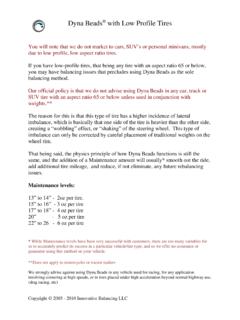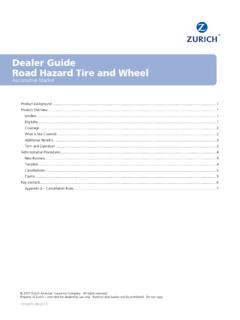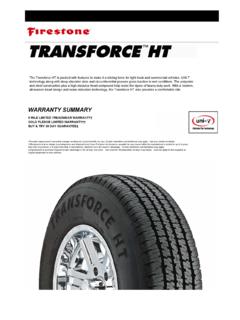Transcription of RV Tire Deterioration Article - NitroFill
1 RV Tire Deterioration By Doug Hildreth (01/05). In the old days, we simply said, "It wore out". These days we look more deeply into the hows and whys. With tires, particularly RV tires, there are some specific chemical changes that occur within the tire as time goes on that cause the tire to "deteriorate". Tires are made of a rubber polymer, Sulfur, and Carbon. These chemicals are combined at high heat (vulcanization) to form divalent chemical bonds between the substances to give the desired characteristics of elasticity, flexibility, durability, and strength. There are also other additives whose purpose is to slow down tire Deterioration . There are also "belts" of synthetic material and/or steel wires to give additional strength. Heat (Under inflation) Some of the factors which cause Deterioration have been known for some time. And some factors are currently under investigation and are still in the "theory stage". One of the most significant factors in tire Deterioration is under inflation.
2 This puts stress on the rubber in several ways, the most important being overheating. This was seen in the Ford Explorer-Firestone tire separation phenomenon which we remember from a few years ago. As all of us RVers know, heavier loading of the vehicle requires higher tire pressures, or said another way, overloading an already under inflated tire dramatically compounds the problem. And overloading a properly inflated tire beyond it's maximum weight rating is probably the most common cause for RV tire failure, since weights by the RV Safety Foundation show 60% of RVs to be overloaded on at least one corner. Ultraviolet light Another reported factor in tire Deterioration is ultraviolet light. This comes from the sun and its energy causes chemical changes within the rubber. It is not entirely clear to me exactly how important UV damage is, but some of us try to cover our tires when parked anyway. One of the additives to tires is a wax that blocks UV light. But to be effective, the compound must work it's way to the surface of the sidewall of the tire.
3 This happens when the sidewall is flexed and heated during normal driving. But it does not get replenished to the surface when the tire is sitting still. Since only a small percentage of RVs I see have tire covers, there are a large number of outside dual tires with UV damage. This should result in a higher frequency of outside dual tire failure. However, it is reported that the inside dual fails more often then the outside (probably because it carries more weight due to road crowning). Rusting Another form of Deterioration that occurs is rusting of the steel belts. To get rust, we must have iron (steel), oxygen, and water. Now it has been claimed for some time that the water gets in from outside. That small cracks or cuts or damage to the rubber will allow water to be absorbed through the rubber into the steel belts to start the rusting process. Most of us are aware of this concept in the form of a recommendation that we use some type of a "vapor barrier" under all our tires.
4 I had one tire manufacturer tell me that asphalt is bad and cement is OK, and the next one tell me just the opposite. I have always had some trouble with the concept of the tire sucking up water from the ground, but my opinion and the facts may not be the same. Apparently the move is to coat the steel wires with copper to prevent rusting (one report) or brass to improve rubber adherence to the belts and prevent tread separation (another source). But another theory is that the water comes from inside the tire. Air is made up essentially of 20% oxygen, 80% Nitrogen, a minute amount of other gases, plus a bit of water vapor (depending on where you live, it may be more or less). Now to fill a tire, you need air under pressure. An air compressor takes a large volume of air, and compresses it into a small volume. This means you end up with a large amount of water vapor in the air that you put into your tires. And that water vapor is under 80 (or more) pounds per square inch of pressure.
5 Although the liner of the tire is designed to prevent things from being pushed through it into the rubber, the liner does not work perfectly, nor forever. So the current theory is that the water responsible for rusting the steel belts comes from the compressed air. Oxidation The chemical changes that occur to the rubber polymer during the manufacturing process produces a number of bivalent chemical bonds between the molecules. The primary change that occurs during Deterioration of a tire is the creation of more chemical bonds between the molecules as time goes on, a process called oxidation. This is a bad thing because then the rubber becomes stiff (not flexible) and hard, which will lead to tread separation, blowouts and disintegration. Keep in mind that the speed of any chemical reaction doubles with a rise in temperature of 10 degrees Centigrade (approximately 18 degrees Fahrenheit). The tire does not care whether the temperature rise is the result of under inflation/overloading or hot outdoor weather.
6 Oxygen is a relatively weak chemical oxidant. It will combine with other substances (such as iron, to form rust), but it happens relatively slowly. Ozone is a strong chemical oxidant. It is formed in the atmosphere by lightening (or electric motors, like those on air compressors) and UV radiation. It's molecule has 3 atoms of oxygen as opposed to the usual 2 atoms of ordinary oxygen. So the current thinking is that the presence of ozone (and other oxidants) inside and to a lesser extent outside, the tire may be the prime culprit in tire Deterioration (the making of excessive bonds between rubber polymer molecules). As with water vapor, it seems more likely for ozone and other oxidants to be forced into the tire from the inside (high pressure) than to be "invading" the tire from the outside. But "seems more likely" may not equal a fact. So during manufacturing, antiozonants and antioxidant chemical compounds are added. These appear to slow the oxidative process. But they get used up in the process of neutralizing the oxidants.
7 They also seem to work better when the tire is flexed and heated during use. Nitrogen The next step in the attempts to slow Deterioration was the introduction of pure Nitrogen for inflation of tires. This has become more practical with the advent of modern membrane technology, whereby air is taken in and passed through a semipermeable membrane where the oxygen, ozone and water vapor escape out through the membrane, and nearly pure nitrogen goes into the tank. Nitrogen inflation has been used for many years in airplanes, race cars, bicycle racing, military and fire vehicles, and a few trucking firms. Less pressure change during a race (better handling), cooler running tires, longer tire life and fewer sudden tire failure result. One trucking company who runs over 2 million miles a day averaged 35 failures per day. After inflating with Nitrogen, they are having 5 failures per day, three quarters of which are road hazard damages. Nitrogen is totally inert, that is it is very reluctant to get involved in chemical reactions.
8 With nitrogen inflation there is no oxygen, ozone or water vapor inside the tire. Probably the biggest benefit for the trucking industry is that nitrogen diffuses through the tire more slowly than oxygen. This means that tires hold their pressure longer (although I almost never loose air from my tires). So there is less likely to be under inflation with nitrogen. Tires also run cooler with nitrogen, and the rise in tire pressure after driving is less (air filled tires went from 95 to 120 psi, Nitrogen tires went from 95 to 100). Most of the temperature and pressure rises are felt to be caused by the water vapor. A number tire dealers, truck stops, Wal-Marts and Costcos around the country are providing nitrogen inflation. Nitrogen is not recommended for old tires, but should be considered for new ones (or a few months old??). In an urgent situation you can add air to a nitrogen filled tire and replace the Nitrogen when you get home. Although it is attractive to have our RV tires hold their pressure longer, the biggest potential for RV tires inflated with nitrogen is they appear to undergo a more gradual oxidation- Deterioration , based on the trucking reports.
9 Fewer sudden events (blowouts). seem to occur. If this is substantiated on large RV (and truck) trials, our tires may stay softer, more flexible, stronger, and with less rusting. Hopefully we will be able to safely run for longer periods before replacing. Tires start to deteriorate as soon as they are made. Look on your sidewall to see the week and year your tires were produced. Thicker tires (truck) tend to last longer than passenger tires in part because it takes longer for the oxidant-bonding process to work through the tire. Truck tires also last longer because they are used every day and the regular flexing and heating is beneficial. The majority of experts feel that 5 years is the maximum time to run an RV tire. It may be that by using Nitrogen, we will be able to significantly slow the Deterioration process, reduce the risk of sudden tire failure and extend tire life another year or or more? Recommendations Look at your tires for tread wear and sidewall defects Weigh your RV on all four corners Get a weight/tire pressure chart from your tire manufacturer Get the maximum speed rating of your tires from the manufacturer Read the maximum cold tire pressure on the sidewall Inflate your tires to the proper pressure.
10 Check pressure frequently. Increase tire pressure when you are loaded. Strongly consider a remote tire pressure monitoring device (toad too). Don't allow yourself to overload (weigh frequently). Keep track of your date of manufacture. Don't go over 5 years Use sun protection and vapor barriers to make yourself feel better If using your own compressor, empty the water frequently If you have a choice, fill your tires on low humidity days Try to find a shop that uses a "dryer" on their air compressor Give serious consideration to nitrogen inflation with new tires Drive your RV. When I graduated, our professor announced, "We have some bad news; Half of what we have taught you will be proven to be incorrect. We have some really bad news; We are unable to tell you which half.". That's how I feel about this attempt to learn about the subject of tire Deterioration . I. would sincerely appreciate the input and correction from any reader who knows which half I have messed up. Doug BACK.








